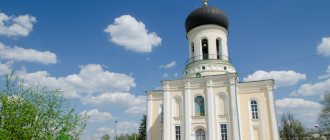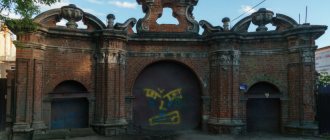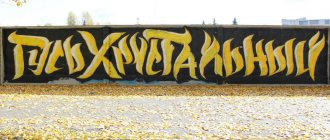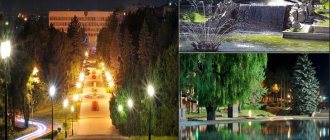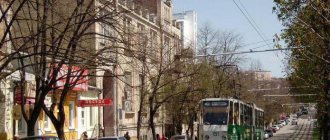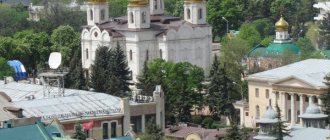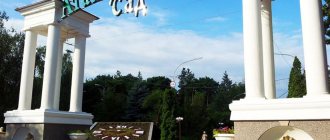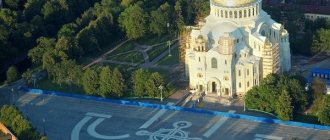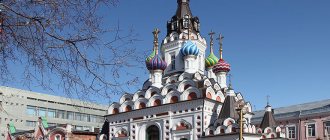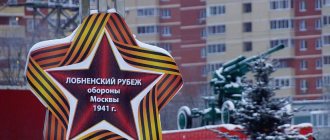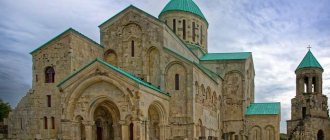| What to see on your own Museums Stories, routes and tips from tourists Where to go for 1 day Where to stay in Pyatigorsk Interesting excursions |
Pyatigorsk is the oldest balneological and mud resort, famous for its healing mineral waters. The hot mineral springs of Mount Mashuk were first explored at the end of the 18th century, and the city dates back to that time. Water treatment is complemented by the healing mud of Lake Tambukan , mountain air and a favorable climate.
To get to know the city, people usually come to Pyatigorsk for several days. During the standard two-week treatment period, resort guests have the opportunity to leisurely get acquainted with all the iconic objects of the resort. As a rule, vacationers from neighboring resort towns or business travelers who have taken a day off from official business come for one day.
What to see in Pyatigorsk in 1 day on your own
Pyatigorsk is the largest and most tourist-rich of the resort towns of the Caucasian Mineralnye Vody. If you only have one day left, you will have to make a choice and set your priorities correctly depending on what you want to see in Pyatigorsk first.
Pyatigorsk is inextricably linked with the name of Mikhail Yuryevich Lermontov. He visited here several times as a child, lived during his exile in the Caucasus, the heroes of his novel walked along the streets of Pyatigorsk; Here Lermontov’s life was tragically cut short in a duel; he was buried in Pyatigorsk land and lay there for several months. Many attractions of Pyatigorsk are associated with M. Yu. Lermontov’s stay in the city.
Monument to M. Yu. Lermontov
Start your walk around the city from the monument to Mikhail Yuryevich Lermontov , which stands in the park, which is also called Lermontovsky. The idea of installing a monument to the poet in Pyatigorsk arose in 1870; they turned to the emperor for permission, and Alexander II gave permission to collect voluntary donations for the construction of the monument. Money has been collected all over the world for more than ten years. In 1881, a competition was announced for the best project; the winner was the sculptor A. M. Opekushin, the author of the well-known monument to A. S. Pushkin in Moscow. The monument to M. Yu. Lermontov was opened in August 1889. This is the first monument to the poet in Russia and one of the main attractions of Pyatigorsk.
Monument to M.Yu. Lermontov Photo: © Anna Kudryavtseva
Spassky Cathedral
The Cathedral of Christ the Savior Healing the Paralytic at the Sheep Font , or Spassky Cathedral, was recreated on the site of a temple built in 1847–1869 and blown up in 1936. It was consecrated in 2012; it is the cathedral of the Pyatigorsk diocese, which includes the parishes of the Mineralovodsk, Predgorny and Kirov regions of the Stavropol Territory, as well as Kabardino-Balkaria and Karachay-Cherkessia.
Spassky Cathedral Photo: © ValentinaD
Park "Flower Garden"
Tsvetnik Park is the oldest park in Pyatigorsk, for almost two centuries the center of the city’s resort life and its vibrant brand. At the beginning of the 19th century, there was a swampy area where water from sulfur springs flowed from Mount Goryachaya. In 1828, they did a lot of work and created a cozy corner, which was called the “Flower Garden” due to the abundance of flower beds. The famous architects Bernardazzi brothers worked on its improvement. The flower garden was called Nikolaevsky because of the Nikolaevsky baths located nearby.
The park has been landscaped for decades, expanded, and decorated with new flower beds, fountains and gazebos. In 1907, a wooden arch of the entrance to the park was erected in the Art Nouveau style, and nearby, according to the design of the architect S.I. Gushchin, a wonderful airy building was built for the coffee shop of the confectioner A.A. Gukasov. The monument to Kisa Vorobyaninov , a famous character in the film adaptation of the novel by Ilya Ilf and Yevgeny Petrov “12 Chairs”, filmed by Leonid Gaidai, was installed today. As in the past, the park today is a favorite place for recreation and walks for local residents and city guests.
Park "Flower Garden" Photo: © Sergey Makhinin
Lermontov Gallery
At the beginning of the 20th century, the resorts of the Caucasian Mineral Waters were actively improved. In this regard, it was decided in Pyatigorsk to erect a building made of metal and glass, fashionable at that time, for walks in bad weather, as well as for performances by orchestras, invited performers and theater groups. Soon, the KMS Administration entered into an agreement for the design, manufacture and installation of galleries with the Warsaw. The gallery opened to visitors in 1901 on the 60th anniversary of the death of M. Yu. Lermontov, and therefore was named after him. Many famous people performed here, including Chaliapin, Ermolova, Sobinov, Mayakovsky.
of the Lermontov Gallery to this day almost unchanged. Nowadays it belongs to the North Caucasus State Philharmonic named after V.I. Safronov, and houses concert and exhibition halls.
Lermontov Gallery Photo: © ValentinaD
Diana's Grotto
Take a look at Diana's Grotto , which is located on the northern slope of Mount Goryachaya to the right of the Lermontov Gallery. This is an artificial cave, built according to the design of the Bernardazzi brothers in 1831 in memory of the first ascent of Elbrus by members of the expedition led by General G. A. Emanuel. At the entrance to the grotto, two cast-iron boards were installed with texts (in Russian and Arabic) about this ascent.
The grotto was named after Diana, the patroness of hunting in ancient Roman mythology. According to contemporaries, M. Yu. Lermontov was a frequent visitor to Diana’s grotto; there is a memorial plaque about this on the wall inside.
Diana's Grotto Photo: © Anna Kudryavtseva
Mountain Hot
From the grotto, climb Mount Goryachaya - the ancestor of both the resort and the city of Pyatigorsk. Even in ancient times, the inhabitants of these places carved stone pools on its top, filled with freely flowing healing water. These pools were used by soldiers of the Constantinogorsk fortress at the end of the 18th century, and later primitive baths were built on the mountain for the first resort visitors.
There is an openwork Chinese gazebo and a wonderful observation deck, which offers a wonderful view of the city and Mount Beshtau , and the main mountain of Pyatigorsk, Mashuk, is clearly visible. In 1903, for the 100th anniversary of the resort, a sculpture of an eagle , which became the emblem of not only the Pyatigorsk resort, but also the entire Caucasian Mineral Waters region. Its author embodied in stone a mountain legend about an eagle that was fatally stung by a snake and found deliverance from imminent death in a stream of healing water on Goryachaya Mountain. Favorite place for photo shoots of tourists.
Don't miss also the Open Air Museum of Antiquities, revived on Goryachaya Mountain several years ago. The Pyatigorsk Museum of Stone Antiquities, which existed from 1850 to 1881, was the first not only in the North Caucasus, but also in Europe. The idea of restoring this museum belonged to the city’s Local History Museum; now it and the Museum of Stone Antiquities are connected by the “630 Steps” excursion route.
Sculpture of an eagle and a Chinese gazebo on Mount Goryachaya Photo: © Anna Kudryavtseva
Ermolovskie baths
Ermolov Baths building is a real decoration of Pyatigorsk thanks to its unusual architecture. A bathroom building with this name existed even when the resort was called Hot Waters - since 1820. The family of General N.N. Raevsky, A.S. Pushkin, composer M. Glinka, Denis Davydov and many famous people of that time took baths here. The name of General A.P. Ermolov was given to the hospital in recognition of his services in the development of the resort business in the Caucasian Mineral Waters.
This building on the territory of the Tsvetnik park was inaugurated in 1880; inside there were bathing cabins filled with mineral water from the Alexander Spring. But the Ermolovsky baths have repeatedly changed the profile of their therapeutic activities. First, two mud baths were added, then there were more of them, and until the opening of the Pyatigorsk mud baths in 1914, this was the main mud bath of the city.
Ermolov baths Photo: © Anna Kudryavtseva
Operetta theater
The beautiful building of the Operetta Theater was built in 1915 according to the design of the architect A.I. Kuznetsov as the People's House for the Pyatigorsk public all-class club for the entertainment of the “water society”. The main facade is made of Mashuk stone and yellow brick, and is decorated with decorative ceramic panels. After the revolution, it was the People's House, where revolutionary rallies took place; from its balcony in 1918, Soviet power was proclaimed on the Terek.
The operetta theater in Pyatigorsk was opened in 1939. Now it is the Stavropol State Operetta Theater, beloved by local residents and holidaymakers. Vacationers are also brought to the theater’s performances from neighboring resort towns of the Caucasian Mineralnye Vody.
Operetta Theater Photo: © Anna Kudryavtseva
"Aeolian harp"
A classic rotunda was built in the park according to the design of the architects Bernardazzi brothers in the early 30s of the 19th century. A wooden case with two harps was built into the stone floor of the rotunda; the weather vane on the dome of the gazebo, turning under the influence of the wind, set the device in motion, touching the strings, and melodious sounds were heard. That is why the gazebo received the name “Aeolian Harp” .
M.Yu. Lermontov visited the gazebo more than once; it is mentioned in his story “Princess Mary”: “On the steep rock where the pavilion called the Aeolian Harp was built, lovers of views stuck out and pointed a telescope at Elbrus.” Nowadays the Aeolian harp is equipped with audio equipment and plays regardless of the wind. The gazebo is popular among tourists, as it offers a magnificent view of the city and, if the weather is lucky, of Mount Elbrus.
Gazebo “Eolian Harp” Photo: © Anna Kudryavtseva
Academic gallery
From the platform from the “Aeolian Harp” there is a beautiful view of the Academic Gallery , one of the oldest drinking galleries in Pyatigorsk. It was built by order of Prince M. S. Vorontsov in 1847–1849 according to the design of the Kavminvod architect S. I. Upton over the Narzan drinking spring and was named “Elizavetinskaya” after the name of this source, so named in 1811 by F. Haaz, who discovered it .
The gallery became an academic gallery in 1928 in honor of the 200th anniversary of the Academy of Sciences. A wide staircase with an observation deck at the top leads to it from the Tsvetnik park. There is a beautiful flower clock at the foot of the stairs.
Flower clock near the stairs to the Academic Gallery Photo: © SVM
Lermontov's Grotto
Somewhat below the Aeolian Harp in a steep rock on the spur of Mount Mashuk is the “Lermontov Grotto” . This is a natural cave, which in 1831 was given a decorative appearance by the architects Bernardazzi brothers, making it convenient for visiting, and it became a favorite place for secluded recreation for holidaymakers. M. Yu. Lermontov was also here, admiring the views and watching the public walking below the gallery. It is more convenient to approach the grotto from the Academic Gallery. Do you know that Lermontov’s grotto “played the role” of the entrance to Proval, where Ostap Bender sold tickets, in the famous film by Leonid Gaidai “The Twelve Chairs”?
Lermontov's Grotto Photo: © olgazav59
Failure
Proval is a natural well, at the bottom of which there is a karst lake of turquoise-colored mineral water. M.Yu. Lermontov describes it in his story “Princess Mary”, but in those days there was no tunnel that leads to the underground lake; the walking public climbed the path and looked at the lake from above. The tunnel was dug in 1858, and until 1880 people swam in the lake for medicinal purposes. On the wall in the cave hangs an image of Panteleimon the healer.
It's now a popular tourist attraction, although don't expect much. In any case, you will have the opportunity to take a photo with Ostap Bender, who was selling tickets to enter Proval.
“Failure” Photo: © Anna Kudryavtseva
Mount Mashuk
Mount Mashuk is a natural monument in the resort area of Pyatigorsk. Your tourist routes will definitely lead you to the mountain, since many city attractions are located on its slopes: the Eolian Harp gazebo, Lermontov’s grotto, the Academic Gallery, and “Proval”. There are a lot of interesting things to see at the top of the mountain.
We recommend finding time to climb the mountain, for example, using the cable car . Its length is about 1 kilometer, the carriages have been regularly carrying passengers since the 1970s. The panorama of the city and the views of the surrounding mountains from the cabin are worth it! There is a walking route up the mountain about 4 kilometers long, path routes of varying lengths, as well as several “wild” trails.
View of Pyatigorsk from Mount Mashuk Photo: © kvaky
But this is not all that an inquisitive tourist can see in Pyatigorsk!
More detailed review: Sights of Pyatigorsk
Sights of Pyatigorsk
There are dozens of cultural, historical and natural monuments in Pyatigorsk.
Park "Flower Garden"
The Tsvetnik park has gained great popularity among vacationers. Its construction began in 1828. At first the park was called Nikolaevsky. On the territory of the “Flower Garden” there are pump rooms where you can drink and collect mineral water, fountains, and flower beds. The entrance to the Park from Kirovskaya Street is decorated with beautiful carved gates. You can get to the park by tram or minibus.
The entrance to the Tsvetnik park is framed by elegant gates
There are several attractions located on the territory of the “Flower Garden”:
- Diana's Grotto is a monument associated with the expedition to Elbrus in 1829, in which archaeologists, mineralogists, physicists and other scientists, as well as military personnel and travelers took part. It was headed by General G. A. Emmanuel. The purpose of the expedition was to map the lands and discover secret roads along which weapons were supplied from Turkey. Architect Joseph Bernardazzi took part in the expedition. Only Kilar Khachirov, a local resident and expedition guide, was able to climb to the very top of the mountain. A few years later, in honor of conquering the top of the mountain, the Bernardazzi brothers decided to erect a monument - an artificial cave.
Diana's Grotto in the Tsvetnik park was created in memory of the conquest of the summit of Elbrus - The Lermontov Gallery is one of the oldest chamber music and exhibition halls in Pyatigorsk. The metal and glass gallery project was carried out by the Warsaw joint-stock construction company “Vl. Gostynsky and Co. commissioned by the director of the Caucasian Mineral Waters resort V.V. Khvoshchinsky. The grand opening of the hall took place on July 15, 1901, on the day of memory of M. Yu. Lermontov.
Lermontov Gallery is located in the park - The monument to Kisa Vorobyaninov, the hero of the work “The Twelve Chairs,” is located not far from the park gates. It was in Pyatigorsk that the hero of the book tried to beg and collected alms, posing as a former deputy of the State Duma.
Some park visitors throw coins into Kisa's hat - the hero looks so pitiful
Video: remnants of former luxury - Gukasov’s coffee shop
hot mountain
Mount Goryachaya is known for its abundance of thermal springs. You can get to its slopes directly from the Tsvetnik park - this is the most popular climbing option.
You can get to Hot Mountain directly from the Tsvetnik park.
In every city of the Caucasian Mineral Waters there is a statue of the guardian of the resorts - an eagle. In Pyatigorsk, the sculpture “Eagle Conquering a Snake” is located on Hot Mountain. It is a symbol of longevity, strength and vitality that overcome weakness and illness. Based on the sketches of the artist I. I. Krylov, the Rostov sculptor L. K. Shodkiy made a sculpture of an eagle, which was installed on a pedestal made of stone blocks. The opening of the monument took place on May 1, 1901. This date is considered to be the birthday of the Kavminvod symbol.
After this, the monument was destroyed more than once. In Soviet times, the head and part of the wings were destroyed, because the eagle was perceived by many as a symbol of royal power. It was restored in the 30s. But during the Nazi period, the monument was already associated with the symbol of the Third Reich, and it was destroyed again. The restored sculpture had a lot of new features in its appearance. They removed the too wide wingspan and open beak, which looked quite aggressive.
It is considered a good omen to rub the bird's beak for good luck. Finding the sculpture will not be difficult: past Diana’s grotto, go up the path to the stairs. It will be simply impossible not to notice the bird from there.
The eagle is a symbol of the Caucasus Mining Waters: in Pyatigorsk, a sculpture depicting this bird is located on Hot Mountain
The Pyatigorsk Operetta Theater is located in the former People's House built in 1914, which was designed by A. I. Kuznetsov for the city All-Class Club. The theater received its current name in 1997. During the Soviet years, the building became a platform for rallies and public meetings. In 1920, cultural events began to be held here, and in 1934 the regional drama theater opened its doors. In 1939, the Pyatigorsk Theater of Musical Comedy was created. The theater building is located on the slope of Goryachaya Mountain, next to the Tsvetnik park.
The Pyatigorsk Operetta Theater hosts performances and concerts
Mount Mashuk
Mashuk is a magmatic mountain with which many events in the city are connected.
The origin of its name has several versions. One of them talks about the brave horseman Mashuko, who defended his native land during the Golden Horde. In the battle, the enemy forces prevailed several times, and the hero jumped from the mountain into the abyss without surrendering to the conquerors. Another version refers us to the translation from the Kabardian language: “mash” is millet, “ko” is a place for sowing. That is, the place where millet was sown. There is another beautiful legend that tells about the unhappy love of the beautiful Mashuk and the young man Beshtau, who died defending their love from the formidable Elbrus.
In the depths of the mountain there are thermal waters. From the mountain you can see not only the whole of Pyatigorsk, but also neighboring resorts, as well as Mount Beshtau. At the top of Mashuk there is a television tower. You can climb the mountain on foot, by bike, or by cable car.
You can climb to the top of Mount Mashuk on foot, by bike or by cable car
There are several notable objects located on the slopes of the mountain:
- The Aeolian Harp gazebo, designed by Giuseppe Bernardazzi. It is located in the high part of the Mikhailovsky spur of Mashuk. The architect was inspired by the English pavilion “Temple of Aeolus”. A modernized harp consisting of two simple aeolian harps was fixed in the gazebo. The design was designed in such a way that the blowing wind played on the strings, and music was heard in the mountains. This instrument existed in the gazebo until 1861. In 1890, a simplified aeolian harp was mounted on the roof of the gazebo during the summer season. In 1972, a new electromechanical device was introduced, also controlled by the wind. And since 2008, the gazebo has been equipped with electronic equipment that plays music regardless of the wind. From the height of the gazebo there is a panoramic view of Pyatigorsk and its surroundings. You can get to the gazebo by minibus No. 1, which stops at the beginning of Krasnoarmeyskaya Street. From there you have to walk a little.
Music can be heard from the Eolian Harp gazebo - The place of the tragic duel between Lermontov and Martynov, which took place on July 15 (27), 1841. It is located on the northwestern slope of Mount Mashuk. In memory of the sad event, an obelisk was erected here. In its center there is a round niche in which stands a bronze bust of the poet. The memorial is visited by many guests of Pyatigorsk. On memorable dates, people bring flowers. The memorial is within walking distance from the Lermontovskaya railway station. The bus and minibus stop is called “Place of Lermontov’s duel.” You will need to walk about 650 meters from the stop along the path.
Now at the site of the duel between Lermontov and Martynov there is a memorial obelisk - The Pyatigorsk cable car, which helps you make a sightseeing route along Mount Mashuk. It was built in 1971. The length of the road is 994 meters. It is noteworthy that the road has only two supports - at the end and the beginning of the route. The cableway is designed for the movement of two carriages: they simultaneously start from opposite stops. Their speed is quite high - 8 m/sec - in 3 minutes the entire route will be covered. While driving, passengers have a panoramic view of the mountains and the whole of Pyatigorsk. The cable car operates all year round. Its lower station is located on Gagarin Boulevard.
A compact trailer will take you to the very top of Mount Mashuk in 3 minutes
Mount Beshtau
Mount Beshtau is one of the most majestic in Pyatigorsk. Its height is 1401 meters. The megalithic religious complexes “Temple of the Sun” and “Temple of the Earth” have been preserved on the mountain. But there are also later buildings: a monastery, the remains of fortress bastions. Hiking on the mountain began in the 19th century, when special trails were laid.
The natural world of Beshtau is no less interesting: the trees here are dominated by oaks, hornbeams and ash trees, and an old beech forest has been preserved. Beshtaugorsk poppies, reaching 1.5 meters in height, are striking. You can get to the beginning of the walking route by car along the Beshtaugorsk ring. Public transport running between Pyatigorsk and Lermontov is also suitable: you can get off at the turn of Dachnaya Street (stop “Cemetery”), from which you will have to walk about 3 km to the monastery, then uphill.
Mount Beshtau is one of the most majestic in Pyatigorsk
The Second Athos Holy Dormition Beshtaugorsky Monastery is located on Mount Beshtau. It was founded in 1901 by Russian ascetic monks from Mount Athos. It existed until 1927, and then was destroyed. Its revival began only in 1999.
The Second Athos Holy Dormition Beshtaugorsky Monastery is located on Mount Beshtau
Pyatigorsk Lermontova
In addition to the place where Lermontov’s duel took place on Mount Mashuk, there are several more corners in Pyatigorsk dedicated to the poet:
- Monument to Lermontov in the city center. The idea to erect a monument to the great poet was born 30 years after his tragic death. It was possible to implement it only after 18 years. Donations for the creation of the monument were collected from all over the Russian Empire. More than 150 works were submitted to the sketch competition. The jury chose the project by A. M. Opekushin. The sculpture was cast in bronze at the St. Petersburg factory “A. Moran”, and the pedestal was made of Crimean granite. The monument conveys a sad image: the poet’s gaze is directed into the distance. The opening took place on August 16, 1889. On Lermontov’s birthday and death every year, events are held in the park near the monument where people read his poems.
The opening of the monument to Lermontov took place in 1889 - The house-museum of M. Yu. Lermontov has the status of a federal monument. People call it Lermontov's House. Here the poet spent the final months of his life and wrote his last poems. The house was opened as a museum in 1912.
The house in which M. Yu. Lermontov spent the last months of his life was opened as a museum in 1912 - The house of Princess Mary is a one-story building at 12, Kirov Avenue. The house was built in 1823. The Hungarian artist Mihaly Zichy captured him in one of his drawings from the “Hero of Our Time” series created in 1881. From his paintings we can understand what the buildings looked like at that time. According to the artist, it was the house on Kirov Avenue that most closely matched Lermontov’s description of Princess Mary’s home. The artist’s paintings were included in the illustrative series of the book published at that time. And since then the house has become known to many.
The house located on Kirov Avenue most closely matches the description of the place where Lermontov's Princess Mary lived
Video: guide to Lermontov's places in Pyatigorsk
Fountain on Kirov Avenue
The fountain, located on Kirova Avenue, is probably the most famous in Pyatigorsk. It even has several names: “Fairy Tale”, “Dwarves”, “Grandfathers”, “Giant”. The creation of the fountain dates back to 1890. Due to the strong and powerful flow of water, local residents began to call it “The Giant”. In 1910, the sculptor Karl Ludwig Szodki transformed the fountain into an entire architectural complex. Among the stone pillars resembling grottoes, there are gnomes. The 8 elders seem to be protecting the mountains from uninvited guests. During wartime, the fountain was badly damaged. The sculptor N. M. Khaustov later revived this sculpture, like the famous eagle on Mount Mashuk.
A fountain depicting fairy-tale characters is located on Kirov Avenue
Spassky Cathedral
Spassky Cathedral is the main temple of the city. He had a difficult fate. Construction of the temple began in 1845 in the then fashionable Russian-Byzantine style, which included elements of ancient Russian architecture, as well as details of Byzantine architecture. But it was never completed: cracks began to form in the walls, and as a result the temple was completely dismantled. The contractors were accused of unscrupulous masonry.
Construction of the temple began anew from Mashuk stone and was completed by 1867. The appearance of the temple resembled the Cathedral of Christ the Savior. And their fate turned out to be similar. After the coup d'etat, grain was stored in the temple, and in 1936 it was blown up. Only in the 90s of the 20th century was it decided to restore the temple. On December 14, 2012, the Cathedral was consecrated by the Patriarch.
The Spassky Cathedral in Pyatigorsk is the main one in the city
Park of Culture and Leisure named after Kirov
Pyatigorsk Park of Culture and Leisure named after. S.N. Kirov - a favorite place for family vacations - is located between Danube and Pervomaiskaya streets. The park was founded on the basis of the State Garden that existed since 1835 (later - Karl Liebknecht Park). The central entrance of the park is decorated with a colonnade characteristic of the 50s of the 20th century. The park has a pond with swans, a petting zoo, a boat station, restaurants, cafes, kiosks, and seasonal attractions, most of which are open in the summer. For kids, trampolines and a children's fortress are offered. For older children, ATV rides and a ropes course are suitable. The central entrance to the park is located on Danubesky Street.
In the Pyatigorsk Culture and Recreation Park you can relax in the shade of trees, ride a carousel and stroll along numerous paths
Elsa's house
Elsa's house attracts lovers of mysticism. Some even manage to sneak into it. Now the building is abandoned, located behind a high fence, the passage there is closed. Even from a distance the house looks mysterious and ominous.
They said different things about this beautiful dacha: sometimes about happiness, sometimes about misfortune. Initially, the dacha was built as a boarding house, where rooms were rented out to holidaymakers. Mistress Elsa was a German who married an enterprising Baku resident Arshak Gukasov. The family never had children, which may be why the couple divorced. The house went to Elsa, who continued to live in it and successfully run a hotel business. But since the revolution, versions of urban legends have diverged. According to one of them, Elsa was either shot or walled up in the basement. According to the other, she fled, hiding family treasures in one of the walls in the hope of returning for them.
During Soviet times, the building was a sanatorium, whose guests complained of strange rustling noises, steps and voices. This is how the legend about the ghost of the mistress was born. The house was soon abandoned and is still in poor condition.
Elsa's house attracts lovers of mysticism
Video: Haunted Mansion
Lake Proval
The popularity of the Pyatigorsk Proval was added to the novel “The Twelve Chairs” by Ilf and Petrov. It was here that Ostap Bender sold entrance tickets, and the proceeds allegedly went to strengthen the Proval - so that it would not fail too much. The writers themselves spoke impartially about this lake, calling it a “puddle.”
Near the Proval there is a monument to Ostap Bender, who sells “fake” entrance tickets
In fact, the lake got its unusual smell and turquoise color due to the sulfur contained in the water. It is located in an underground cave and appeared due to the influence of mineral waters. Ancient dachas were built around Proval - they form a small town. The houses appeared at the end of the 19th century and look very original. Among them there are unusual ones, similar to oriental palaces and medieval castles. Today, most of them have been converted into sanatoriums.
Lake Proval has a turquoise color due to the high sulfur content in its waters
Video: TOP 10 remarkable places in Pyatigorsk
Museums of Pyatigorsk in 1 day
It is quite possible to visit the two main museums of Pyatigorsk - the “Museum of Local Lore” and the “State Museum-Reserve of M. Yu. Lermontov” in one day, or choose the one that is most interesting to you.
The most visited museum in Pyatigorsk is the State Museum-Reserve of M. Yu. Lermontov. This is not surprising, Pyatigorsk is a city inextricably linked with the name of Lermontov. The museum was opened in 1912 in the house where the poet spent the last two months of his life and wrote a number of poems. It was here that the poems “I Go Out Alone on the Road” and “The Sea Princess” were created. After the duel, the body of the murdered poet was brought to this house, and he was buried from here. The interior of this house was recreated according to the descriptions of the poet’s contemporaries; it contains things that M. Yu. Lermontov used during his life.
Now the museum occupies an entire block. In the former house of General P. S. Verzilin, ataman of the Caucasian Cossack Line Army, where the poet often visited in the summer of 1841 and where he was challenged to a duel by Martynov, there is a literary exhibition of the museum dedicated to the theme “M. Yu. Lermontov in the Caucasus.”
Next door, the corner house of the museum quarter is the former house of I.V. Umanov. Lermontov visited his friends here in 1841. For example, his colleague in the Grodno Hussar Regiment A.I. Arnoldi lived here. The department “Lermontov in Fine Arts” is located in the house of I.V. Umanov.
The Lermontov Museum includes the house of A. A. Alyabyev. This is the house of Major Karabutova, where in 1832 the famous Russian composer A. A. Alyabyev, who was undergoing treatment in Pyatigorsk, rented an apartment. Here he created several works on the Caucasian theme. This house has two exhibition halls where you can get acquainted with paintings and graphic works from the museum’s collection, and personal exhibitions of artists are held. One of the sections of the exhibition is dedicated to A. A. Alyabyev’s stay in the Caucasus. There is also a cozy concert hall.
We recommend that you read reviews about visiting the museum: from Valentina “Lermontov’s House in Pyatigorsk” and Olga “Around Lermontov’s places.”
House M.Yu. Lermontov Photo: © ValentinaD
Pyatigorsk Museum of Local Lore is one of the oldest museums in the region; it was founded in 1903. Its permanent exhibition includes four exhibitions, and temporary exhibitions are also often organized from its own and borrowed funds.
What can you see in the permanent exhibitions of the museum:
- The exhibition “Natural Features of the Caucasian Mineral Waters Region” presents models of the Mashuk and Beshtau mountains, relief maps of the region, collections of minerals and minerals, paleontological finds, stuffed birds and animals. It is here that the skull and skeletal parts of the Southern Elephant can be seen;
- The exhibition “Pages of the History of Pyatigorsk” presents archaeological finds from various eras, samples of weapons from the 18th - early 20th centuries, materials on the history of the city from the 19th to the beginning of the 20th century, historical maps, household items of the inhabitants of Pyatigorsk;
- The exhibition “Great Victory” is dedicated to the Great Patriotic War and contains materials on the battle for the Caucasus and the defense of Pyatigorsk, photographs, awards and personal belongings of city residents who took part in the war, samples of weapons and military equipment;
- The exhibition “Giving Relics and Memory” is dedicated to the people who helped shape the museum’s fund.
The museum also has a Fine Arts Hall, where rotating exhibitions from the museum’s funds, private collections and third-party organizations are held.
Entrance to the Pyatigorsk Museum of Local Lore Photo: © Official website of the museum
Description of the city
Pyatigorsk is a city in the Stavropol Territory. In 1863, a balneological society was formed here. The therapeutic base of health resorts consists of more than 40 mineral springs with water of different chemical compositions and temperatures. Pyatigorsk received the status of a “natural museum of mineral waters”.
In addition to medical procedures, Pyatigorsk offers its guests an extensive excursion program. Many of the city's attractions are associated with famous people who visited these places. Pyatigorsk has a special connection with M. Yu. Lermontov: the poet often visited here, mentioned the region in his famous work “Hero of Our Time” and here he tragically died in a duel.
Historical data suggests that the territory of Pyatigorsk has been inhabited since ancient times. Even then, people knew about the healing properties of local waters. This is evidenced by ancient baths cut down at the springs of the Hot Mountain. The official founding date of the city is 1780 - the time of construction of the Constantine Fortress. A village arose around it where families of retired soldiers lived. Soon, more and more neighbors began to learn about the extraordinary properties of local water, and almost the entire country began to travel to Pyatigorsk.
The Pyatigorsk baths near the springs were cut down many years ago
Now Pyatigorsk is the largest resort of the Caucasian Mineral Waters. In terms of population, this city ranks second after Stavropol. The area of the city is 97 km2. The majority of people living in Pyatigorsk are Russians, there are also Armenians, Azerbaijanis, and Ukrainians.
Stories, routes and tourist tips
If you are planning a trip to Pyatigorsk, we recommend that you get acquainted with real reviews from tourists or stories from local residents, since very often it is from there that you can glean interesting routes, unusual places and unusual ideas.
Take a look at the stories of tourists:
- Impressions of Olga’s trip in the story “The City Where the Soul Resting”
- Routes around the city from Sergei Makhinin “Walk around Pyatigorsk”
- Anna's memories of the trip "Cities of Kavminvod - Pyatigorsk."
We also remind you that the site has a “Questions and Answers” , where, if necessary, you can not only check with experts for up-to-date information about specific city attractions, but also seek advice on issues that interest you regarding your planned trip to Pyatigorsk.
All tourist reviews about the trip to Pyatigorsk on Tourist. RU
Chinese gazebo on Mount Goryachaya Photo: © Anna Kudryavtseva
Where to go from Pyatigorsk for 1 day
If you are already familiar with Pyatigorsk or have free time, you can go get acquainted with the neighboring resort towns. All of them are no less interesting and rich in attractions, they are located quite compactly and are accessible for an independent trip for one day.
We suggest going to Kislovodsk , the most popular of the resort towns of the Caucasian Mineral Waters. The easiest way to get there from Pyatigorsk is by train, which will get you there in fifty minutes. Pay attention to the Kislovodsk Railway Station , it was built in 1854 along with a railway line from Mineralnye Vody, which connected the resort towns of the KMV.
Opposite the station there is a beautiful building of the former Kursaal, which now houses the State Philharmonic. V. I. Safronova . Once upon a time, the resort public, who arrived on commuter trains from neighboring cities, immediately walked from the station up the stairs to the Kursaal, where Fyodor Chaliapin, Leonid Sobinov, Isadora Duncan and other famous artists gave concerts.
Resort Boulevard of Kislovodsk Photo: © Natalia Semchina
Walk along Kirov Avenue to the main tourist street of Kislovodsk - Kurortny Boulevard , where resort life is in full swing at any time of the day. Here are the most beautiful flower beds, most of the city's architectural attractions, restaurants, cafes and souvenir shops. It’s worth staying in the city until the evening to see the light and music fountain . Believe me, it surprises even the most experienced tourists. On the boulevard you will not be left indifferent by the magnificent buildings of the Main Narzan Baths and the Narzan Gallery , where the resort public has been drinking from the Narzan pump rooms for more than a century and a half. Try which narzan do you like better, sulfate or dolomite, hot or cold?
Be sure to take a walk through the famous Resort Park of Kislovodsk. Its territory is huge, you can walk for more than one day. But don't rush, enjoy a leisurely walk. Enter the park through the Colonnade of the main entrance, walk along the main alley past the Flower Calendar, the monument to A.S. Pushkin, the Glass Stream to the Ladies' Whim bridge , go up to the Red Stones and exit the park along the Cascade Staircase " . If you have enough time, you can climb to the highest point of the park, Mount Small Sedlo , using the services of a cable car . the “Valley of Roses” , Blue Stones and the panorama of Kislovodsk from above
Tips for planning your trip will be useful:
“What to see in Kislovodsk in 1 day” “What to see in Kislovodsk in the summer”
Reviews from tourists about a trip to Kislovodsk
If you are not interested in both architectural sights and leisurely walks, Kislovodsk still has something to offer you! In Kislovodsk Park there are path routes of varying difficulty levels, the main thing is to choose a path that suits your abilities. And we suggest you take the tourist route, which is called the “Kosygin trail”. On this trail you can feel unity with nature and take a break from the bustle of cities.
The latest review of the hike along the “Kosygin trail” from Natalia Semchina
Hiking trail in the Resort Park Photo: © Natalia Semchina
How to get to Pyatigorsk
There are several ways to get to Pyatigorsk:
- By plane is the most convenient and fastest way. The nearest airport is 25 km from the city, in Mineralnye Vody. It accepts aircraft from Rossiya Airlines, Donavia, Ural Airlines, Taimyr, Sibir, UTair, Nordstar, and Red Wings. There are flights from all Moscow airports. Suburban trains, buses and minibuses travel from Mineralnye Vody to Pyatigorsk;
- trains that run from different cities of Russia. A branded train “Caucasus” departs from Moscow daily to Kislovodsk. Travel time to Pyatigorsk will be about a day. Trains also go to Pyatigorsk from St. Petersburg, Volgograd, Yurga, Rostov-on-Don, Krasnoyarsk, Essentuki, Krasnodar;
- by bus. Regular buses depart from the Moscow bus stations Orekhovo (metro station "Orekhovo") and Krasnogvardeiskaya (metro station "Krasnogvardeiskaya"). The trip will take approximately 26 hours.
Where to stay in Pyatigorsk
Pyatigorsk is a large resort city offering guests different types of accommodation. There are several sanatoriums offering healing with medicinal waters, hundreds of 3-4 star hotels and even more guest houses with apartments for those who appreciate home comfort.
It is convenient for an inquisitive traveler to choose accommodation in the historical center of Pyatigorsk, where all the main attractions are located, revealing it as a resort. It is located in the eastern part of the city at the foot of Mount Mashuk.
- Pyatigorsk Hotels
- Hostels for Budget Travelers
- Flats and apartments
- Guest houses in Pyatigorsk
Saving on travel by booking accommodation on Booking.com with cashback is not only pleasant, but also useful for new holiday opportunities. Cashback promotion on Tourist. RU
Photo: © olgazav59

